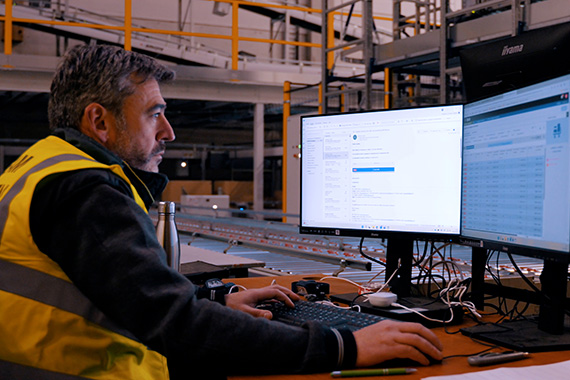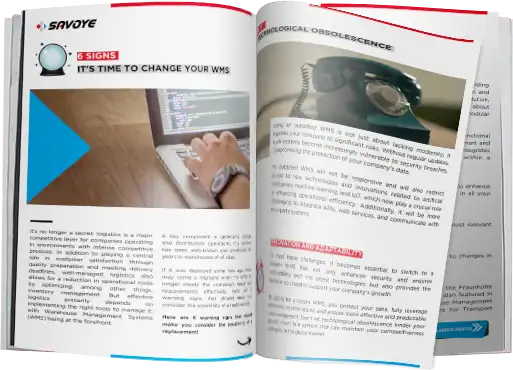When should you change your WMS? Here are 6 warning signs that should make you consider the possibility of a replacement!
#1 TECHNOLOGICAL OBSOLESCENCE
Using an outdated WMS is not just about lacking modernity; it exposes your company to significant risks. Without regular updates, such systems become increasingly vulnerable to security breaches, compromising the protection of your company’s data.
An outdated WMS will not be responsive and will also restrict access to new technologies and innovations related to artificial intelligence, machine learning, and IoT, which now play a crucial role in enhancing operational efficiency. Additionally, it will be more challenging to integrate APIs, web services, and communicate with third-party systems.
- INNOVATION AND ADAPTABILITY
To meet these challenges, it becomes essential to switch to a modern WMS that not only enhances security and ensures compatibility with the latest technologies but also provides the flexibility you need to support your company’s growth.
By opting for a recent WMS, you protect your data, fully leverage technological innovations, and ensure more effective and predictable cost management. Don’t let technological obsolescence hinder your growth: invest in a system that can maintain your competitiveness and agility in the global market.
#2 LACK OF AGILITY
Your company is evolving rapidly, and so are your logistical needs. In a dynamic environment, it is crucial that your WMS can adapt smoothly and continuously. A rigid WMS, which does not allow for the quick integration of new management rules or features, quickly becomes an obstacle to your growth. This lack of agility can limit your ability to respond effectively to new market opportunities or unforeseen operational challenges. Consequently, if your current WMS is not designed to evolve with your business, it risks hindering not only your development but also your ability to stay competitive in a constantly changing sector.
- UNRESTRICTED CUSTOMIZATION
The solution? Opt for a WMS with a fully configurable business rules engine, offering advanced customization and great agility. This engine will allow your teams to define, adjust, and refine your management rules autonomously, without limitations on the number of parameters and without requiring specific technical skills. With this flexibility, you can quickly adapt to changes in your business, adjusting your processes in real time to meet new market or customer demands. A truly agile WMS aligned with your business needs will help you maintain a strong and sustainable competitive advantage.
#3 HIGH SERVICE COSTS
If the costs of services and support for your WMS are increasing, it is crucial to reconsider your technological choice. Outdated or poorly designed WMS systems may require frequent and costly technical assistance, without delivering the expected results. These unexpected expenses can not only impact your operational budget but also hinder your ability to invest in other strategic areas of your supply chain.
- ENHANCED BUDGET CONTROL
By opting for a modern and up-to-date WMS, you can significantly reduce long-term maintenance costs while optimizing your operational efficiency and improving the overall performance of your warehouse. Designed to offer optimal reliability through regular updates and effective technical support, a recent WMS enables more predictable and controlled cost management.Its modular and scalable structure makes it easier to adjust functionalities according to your evolving needs, thereby minimizing future modification costs. Investing in technology that genuinely supports your business strategy allows you to focus your resources on innovation and growth, thereby strengthening your competitiveness in the global market.
#4 A PERFORMANCE ISSUE
A WMS that slows you down and can no longer meet the demands of your business presents a significant performance problem for your supply chain. Degraded response times could lead to errors, delays in daily operations, decreased productivity, and ultimately impact customer satisfaction.
If your system struggles to process transactions, generate reports, or update information in real-time, it’s a strong signal that it’s time to adopt a more efficient solution.
- RESPONSIVENESS AT THE HEART OF YOUR PRIORITIES
To avoid these performance issues, consider moving to a more modern and responsive WMS. Performance is greatly influenced by the technical architecture used, as well as the methodology and technical expertise of the vendor. By engaging with experienced teams specializing in best practices in development, you will benefit from a reliable and high-performing solution. This will allow you to automate your processes, reduce processing times, and optimize your workflows.By enhancing the productivity of your supply chain, you ensure customer satisfaction while remaining agile and competitive in a highly competitive market.
#5 A MANAGEMENT PROBLEM
To make informed decisions and stay competitive in a constantly evolving environment, having comprehensive visibility and advanced analytical capabilities of your logistics operations is crucial. If your current WMS does not provide accurate reports or real-time KPIs on overall performance, inventory levels, and movements, you are missing a valuable opportunity to optimize your processes and respond effectively to market demands.
- ANTICIPATE TO REACT BETTER
It is important that your WMS offers more than just basic operational management; it should provide advanced operational intelligence. Through a management dashboard, you should have access to customized reporting and KPIs for complete visibility into your operations.Customizable dashboards offer an instant overview of your warehouse performance, while predictive analytics help you anticipate demand fluctuations and adjust your strategies accordingly.By leveraging these insights, you can not only optimize your logistics processes but also continually enhance your operational efficiency.
#6 A BARRIER TO AUTOMATION
Automation is no longer just an option; it’s an opportunity for any business looking to stay competitive. It offers significant benefits in terms of operation speed, productivity improvement, and customer satisfaction, while also reducing the physical strain on operators. However, to fully capitalize on these advantages, it is essential that your WMS can effectively support automated processes. If your current system lacks functional flexibility, robustness, or advanced interfacing capabilities, it may become a real obstacle to automating your logistics operations.
- UNLOCK YOUR POTENTIAL
To thrive in an environment where automation plays a central role, a modern WMS is essential. It must be capable of adapting to both manual and automated logistics processes, efficiently managing increased information flows, and seamlessly connecting with Warehouse Control Systems (WCS). Real-time monitoring tools will allow you to detect and correct anomalies quickly, ensuring optimal control over operations.Investing in a WMS that supports your automation initiatives enables you to unlock your warehouse’s potential, enhance operational efficiency, and strengthen your competitiveness in the market.






